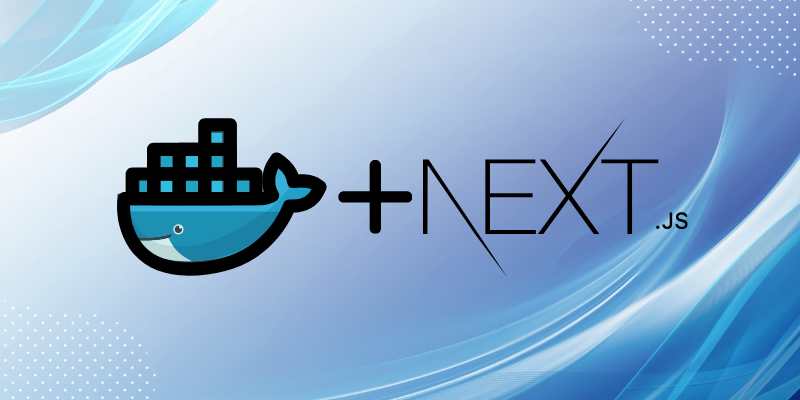If you are looking for a simple Dockerfile for your Next.JS application, this is for you.
In the world of modern web development, Next.js has emerged as a powerful framework for building server-side rendered React applications. Paired with Docker, it becomes even more potent, offering consistency across development and production environments. This blog post will dive deep into creating Dockerfile for Next.js applications, exploring best practices, optimization techniques, and common pitfalls to avoid.
Understanding the Basics
Before we delve into the specifics of Dockerizing a Next.js application, let’s briefly recap what Docker and Next.js are:
- Docker is a platform for developing, shipping, and running applications in containers. Containers are lightweight, standalone, and executable packages that include everything needed to run a piece of software.
- Next.js is a React framework that enables server-side rendering, static site generation, and other performance optimizations out of the box.
Now, let’s explore how we can bring these two technologies together.
Creating a Basic Dockerfile for Next.js
Here’s a simple Dockerfile that can be used as a starting point for most Next.js applications:
# Use an official Node.js runtime as the base image
FROM node:18-alpine
# Set the working directory in the container
WORKDIR /app
# Copy package.json and package-lock.json to the working directory
COPY package*.json ./
# Install dependencies
RUN npm install
# Copy the rest of the application code
COPY . .
# Build the Next.js application
RUN npm run build
# Expose the port the app runs on
EXPOSE 3000
# Start the application
CMD ["npm", "start"]Let’s break down this Dockerfile:
- We start with a Node.js base image, specifically the Alpine version for a smaller footprint.
- We set the working directory to
/app. - We copy the
package.jsonandpackage-lock.jsonfiles first to leverage Docker’s layer caching. - We install the dependencies.
- We copy the rest of the application code.
- We build the Next.js application.
- We expose port 3000, which is the default port for Next.js.
- Finally, we specify the command to start the application.
Best Practices
When Dockerizing a Next.js application, keep these best practices in mind:
- Use .dockerignore: Create a
.dockerignorefile to exclude unnecessary files from your Docker context, such as.git,node_modules, and.next. With this approach, we can reduce the container’s size which increase the performance, build, and deploy time. - Leverage caching: Copy
package.jsonandpackage-lock.jsonseparately before the rest of your code to take advantage of Docker’s layer caching mechanism. - Use multi-stage builds: This helps create smaller production images by leaving build tools and dependencies behind in the build stage.
- Run as non-root user: For security reasons, it’s best to run your application as a non-root user.
- Use specific versions: Always use specific versions of Node.js and other dependencies to ensure consistency.
- Optimize for production: Set
NODE_ENVto production and consider usingnpm ciinstead ofnpm installfor a clean install of dependencies.
Handling Environment Variables
Next.js applications often require environment variables. Here’s how to handle them in your Dockerfile:
- Use
ARGin your Dockerfile for build-time variables:
ARG NODE_ENV=production
ENV NODE_ENV=${NODE_ENV}- Use
ENVfor runtime environment variables:
ENV PORT=3000- For sensitive information, consider using Docker secrets or environment variables at runtime:
docker run -e API_KEY=your_api_key your_imageCaching and Performance
To improve build times and application performance:
- Use
npm ciinstead ofnpm installfor a clean, reproducible build. - Consider using
npm cache clean --forcebeforenpm cito ensure a clean cache. - Use the
--productionflag withnpm cito skip dev dependencies. - Leverage Next.js’s static optimization features to generate static HTML where possible.
Common Pitfalls
Watch out for these common issues when Dockerizing Next.js applications:
- Ignoring
.nextcache: The.nextfolder contains the build cache. Don’t ignore it in your.dockerignorefile if you want to leverage incremental builds. - Not handling server-side rendering: If your app uses server-side rendering, ensure your Dockerfile is set up to support it.
- Overlooking TypeScript: If your project uses TypeScript, make sure to include the TypeScript compilation step in your Dockerfile.
- Forgetting to copy public assets: Don’t forget to copy the
publicfolder to your production image.
Conclusion
Dockerizing a Next.js application brings numerous benefits, including consistency across environments, easier deployments, and improved scalability. By following the best practices outlined in this guide, you can create efficient, secure, and performant Docker images for your Next.js applications.
Remember, the process of Dockerizing your application is iterative. As your application grows and changes, you may need to revisit and refine your Dockerfile. Keep experimenting, measuring performance, and optimizing to get the most out of Docker and Next.js.
Happy Coding!

